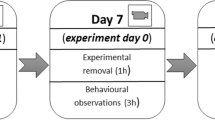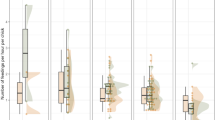Abstract
Biparental care presents an interesting case of cooperation and conflict between unrelated individuals. Several models have been proposed to explain how parents should respond to changes in each other’s parental care to maximize their own fitness, predicting no change, partial compensation, or matching effort as a response. Here, we present an experiment in tree swallows (Tachycineta bicolor) in which we increased the offspring provisioning of females by presenting them, but not their mates, with additional nestling begging calls using automated playbacks. We performed this experiment in two populations differing in future breeding opportunities. We found that in response to a temporary increase in female parental effort, males in the northern population (with lower future breeding opportunities and thus higher brood value) matched the increased effort, whereas males in the southern population did not. We also found that increases in parental care during playbacks were driven by the females (i.e., females initiated the increased effort and their mates followed them) in the northern population but not the southern population. These results support the idea that with incomplete information about the brood value and need, cues or signals from the partner might become important in coordinating parental care.
Significance statement
Male tree swallows increase parental effort when their mates need to work harder. Using an automated system, we broadcast playback of hungry nestling calls only when the female parent was visiting the nest. In a population where the value of the current brood was high, males significantly increased their provisioning rate, much more than their partners did. Since only the females could hear the playbacks, and the begging of the nestlings did not change in response to the treatment, we suggest that either the males used their partner’s feeding rate as a cue or the females may have communicated to their mates that they should work harder. These results suggest that cues or signals from the partner may be important in coordinating parental care.




Similar content being viewed by others
References
Akçay Ç, Lendvai ÁZ, Stanback MT, Haussmann MF, Moore IT, Bonier F (2016) Strategic adjustment of parental care in tree swallows: life-history trade-offs and the role of glucocorticoids. R Soc Open Sci 3:160740. https://doi.org/10.1098/rsos.160740
Akçay E, Roughgarden J (2009) The perfect family: decision making in biparental care. PLoS One 4:e7345. https://doi.org/10.1371/journal.pone.0007345
Ardia DR (2005) Tree swallows trade off immune function and reproductive effort differently across their range. Ecology 86:2040–2046. https://doi.org/10.1890/04-1619
Bebbington K, Hatchwell BJ (2016) Coordinated parental provisioning is related to feeding rate and reproductive success in a songbird. Behav Ecol 27:652–659. https://doi.org/10.1093/beheco/arv198
Bókony V, Lendvai ÁZ, Liker A, Angelier F, Wingfield JC, Chastel O (2009) Stress response and the value of reproduction: are birds prudent parents? Am Nat 173:589–598. https://doi.org/10.1086/597610
Boucaud IC, Mariette MM, Villain AS, Vignal C (2015) Vocal negotiation over parental care? Acoustic communication at the nest predicts partners’ incubation share. Biol J Linn Soc 117:322–336. https://doi.org/10.1111/bij.12705
Chase ID (1980) Cooperative and noncooperative behavior in animals. Am Nat 115:827–857. https://doi.org/10.1086/283603
Clark RG, Winkler DW, Dawson RD, Shutler D, Hussell DJT, Lombardo MP, Thorpe PA, Dunn PO, Whittingham LA (2018) Geographic variation and environmental correlates of apparent survival rates in adult tree swallows Tachycineta bicolor. J Avian Biol 49:jav-012514. https://doi.org/10.1111/jav.01659
Clutton-Brock TH (1991) The evolution of parental care. Princeton University Press, Princeton, NJ
Cockburn A (2006) Prevalence of different modes of parental care in birds. Proc R Soc B Biol Sci 273:1375–1383. https://doi.org/10.1098/rspb.2005.3458
Cox AR, Robertson RJ, Bradley FC, Wallace RB, Bonier F (2018) Demographic drivers of local population decline in Tree Swallows (Tachycineta bicolor) in Ontario, Canada. Condor (published online, doi: https://doi.org/10.1650/CONDOR-18-42.1) https://doi.org/10.1650/CONDOR-18-42.1)
Dakin R, Ouyang JQ, Lendvai ÁZ, Haussmann MF, Moore IT, Bonier F (2016) Weather matters: begging calls are temperature- and size-dependent signals of offspring state. Behaviour 153:871–896. https://doi.org/10.1163/1568539X-00003370
Dunn PO, Robertson RJ, Michaud-Freeman D, Boag PT (1994) Extra-pair paternity in tree swallows: why do females mate with more than one male? Behav Ecol Sociobiol 35:273–281. https://doi.org/10.1007/BF00170708
Elie JE, Mariette MM, Soula HA, Griffith SC, Mathevon N, Vignal C (2010) Vocal communication at the nest between mates in wild zebra finches: a private vocal duet? Anim Behav 80:597–605. https://doi.org/10.1016/j.anbehav.2010.06.003
Gill LF, Goymann W, Ter Maat A, Gahr M (2015) Patterns of call communication between group-housed zebra finches change during the breeding cycle. Elife 4:e07770
Griggio M, Matessi G, Pilastro A (2005) Should I stay or should I go? Female brood desertion and male counterstrategy in rock sparrows. Behav Ecol 16:435–441. https://doi.org/10.1093/beheco/ari009
Harrison F, Barta Z, Cuthill I, Székely T (2009) How is sexual conflict over parental care resolved? A meta-analysis. J Evol Biol 22:1800–1812. https://doi.org/10.1111/j.1420-9101.2009.01792.x
Hinde CA (2006) Negotiation over offspring care?—a positive response to partner-provisioning rate in great tits. Behav Ecol 17:6–12. https://doi.org/10.1093/beheco/ari092
Hinde CA, Kilner RM (2007) Negotiations within the family over the supply of parental care. Proc R Soc B Biol Sci 274:53–60. https://doi.org/10.1098/rspb.2006.3692
Horn AG, Leonard ML (2008) Acoustic interactions in broods of nestling birds (Tachycineta bicolor). J Comp Psychol 122:298–304. https://doi.org/10.1037/0735-7036.122.3.298
Houston AI, Davies NB (1985) The evolution of co-operation and life history in the dunnock, Prunella modularis. In: Sibly RM, Smith RH (eds) Behavioural ecology: ecological consequences of adaptive behaviour. Blackwell, Oxford, pp 471–487
Houston AI, Székely T, McNamara JM (2005) Conflict between parents over care. Trends Ecol Evol 20:33–38. https://doi.org/10.1016/j.tree.2004.10.008
Johnstone RA, Hinde CA (2006) Negotiation over offspring care—how should parents respond to each other’s efforts? Behav Ecol 17:818–827. https://doi.org/10.1093/beheco/arl009
Johnstone RA, Manica A, Fayet AL, Stoddard MC, Rodriguez-Gironés MA, Hinde CA (2014) Reciprocity and conditional cooperation between great tit parents. Behav Ecol 25:216–222. https://doi.org/10.1093/beheco/art109
Kosztolányi A, Cuthill IC, Székely T (2009) Negotiation between parents over care: reversible compensation during incubation. Behav Ecol 20:446–452. https://doi.org/10.1093/beheco/arn140
Lendvai ÁZ, Akçay Ç, Ouyang JQ, Dakin R, Domalik AD, St John PS, Stanback M, Moore IT, Bonier F (2015a) Analysis of the optimal duration of behavioral observations based on an automated continuous monitoring system in tree swallows (Tachycineta bicolor): is one hour good enough? PLoS One 10:e0141194. https://doi.org/10.1371/journal.pone.0141194
Lendvai ÁZ, Akçay Ç, Weiss T, Haussmann MF, Moore IT, Bonier F (2015b) Low cost audiovisual playback and recording triggered by radio frequency identification using raspberry pi. PeerJ 3:e877. https://doi.org/10.7717/peerj.877
Lendvai ÁZ, Barta Z, Chastel O (2009) Conflict over parental care in house sparrows: do females use a negotiation rule? Behav Ecol 20:651–656. https://doi.org/10.1093/beheco/arp047
Leonard ML, Horn AG (2001) Begging calls and parental feeding decisions in tree swallows (Tachycineta bicolor). Behav Ecol Sociobiol 49:170–175. https://doi.org/10.1007/s002650000290
Leonard ML, Horn AG (2006) Age-related changes in signalling of need by nestling tree swallows (Tachycineta bicolor). Ethology 112:1020–1026. https://doi.org/10.1111/j.1439-0310.2006.01259.x
Leonard ML, Horn AG, Brown CR, Fernandez NJ (1997) Parent–offspring recognition in tree swallows, Tachycineta bicolor. Anim Behav 54:1107–1116. https://doi.org/10.1006/anbe.1997.0559
Leonard ML, Horn AG, Gozna A, Ramen S (2000) Brood size and begging intensity in nestling birds. Behav Ecol 11:196–201. https://doi.org/10.1093/beheco/11.2.196
McCarty JP (2002) The number of visits to the nest by parents is an accurate measure of food delivered to nestlings in tree swallows. J Field Ornithol 73:9–14. https://doi.org/10.2307/4131060
McNamara JM, Gasson CE, Houston AI (1999) Incorporating rules for responding into evolutionary games. Nature 401:368–371. https://doi.org/10.1038/43869
McNamara JM, Houston AI, Barta Z, Osorno J-L (2003) Should young ever be better off with one parent than with two? Behav Ecol 14:301–310. https://doi.org/10.1093/beheco/14.3.301
Meade J, Nam K-B, Lee J-W, Hatchwell BJ (2011) An experimental test of the information model for negotiation of biparental care. PLoS One 6:e19684. https://doi.org/10.1371/journal.pone.0019684
Royle NJ, Hartley IR, Parker GA (2002) Sexual conflict reduces offspring fitness in zebra finches. Nature 416:733–736. https://doi.org/10.1038/416733a
Sandercock BK (2003) Estimation of survival rates for wader populations: a review of mark-recapture methods. Wader Study Group Bull 100:163–174
Schwagmeyer P, Mock DW, Parker GA (2002) Biparental care in house sparrows: negotiation or sealed bid? Behav Ecol 13:713–721
Sol D, Maspons J, Vall-llosera M, Bartomeus I, García-Peña GE, Piñol J, Freckleton RP (2012) Unraveling the life history of successful invaders. Science 337:580–583. https://doi.org/10.1126/science.1221523
Trivers RL (1972) Parental investment and sexual selection. In: Campbell BG (ed) Sexual selection and the descent of man, 1871-1971. Aldine, Chicago, pp 136–179
Whittingham LA, Dunn PO, Robertson RJ (1994) Female response to reduced male parental care in birds: an experiment in tree swallows. Ethology 96:260–269. https://doi.org/10.1111/j.1439-0310.1994.tb01014.x
Winkler DW, Wrege PH, Allen PE, Kast TL, Senesac P, Wasson MF, Llambías PE, Ferretti V, Sullivan PJ (2004) Breeding dispersal and philopatry in the tree swallow. Condor 106:768–776
Acknowledgments
We are grateful to Alice Domalik, Pria St. John (Queen’s University), and Drew Gill and Spencer Gill (Davidson College) for excellent help in the field and for Fruzsina Demcsák (University of Debrecen) for analyzing the begging recordings. We thank Katharina Mahr, the associate editor Marty Leonard, and anonymous reviewers for comments on previous versions of the manuscript.
Funding
This work was supported by a U.S. National Science Foundation (NSF) grant (FB, ITM and MFH; IOS-1145625) and by the Natural Sciences and Engineering Research Council of Canada Discovery Grant (FB). During the preparation of the manuscript, ÁZL was supported by grants from the National Research Development and Innovation Office (OTKA K113108 and TÉT_15-1-2016-0044) and by the Romanian Ministry of Education (PN-III-P4-ID-PCE-2016-0572).
Author information
Authors and Affiliations
Contributions
ÇA and ÁZL designed and coordinated the study, collected field data, carried out data analysis, and drafted the manuscript; MS collected field data and helped draft the manuscript; MFH contributed to the design of the study and helped draft the manuscript; FB collected field data, contributed to the design of the study, and helped draft the manuscript; ITM contributed to the design of the study and helped draft the manuscript. All authors gave final approval for publication.
Corresponding authors
Ethics declarations
Ethical approval
We confirm that the procedures used in the study followed the guidelines for animal care outlined by Animal Behaviour Society and Association for the Study of Animal Behaviour and were approved by approved by the Institutional Animal Care and Use Committee at Virginia Tech (#12–020) and Animal Care Committee of Queen’s University (#2013-019) and the Canadian Wildlife Service (#CA0211). The field research was conducted with a permit from US Geological Survey Bird Banding Laboratory to MS (#22742) and Canadian Wildlife Service permit to FB (#10771).
Conflict of interest
The authors declare that they have no competing interests.
Additional information
Communicated by M. Leonard
Rights and permissions
About this article
Cite this article
Lendvai, Á.Z., Akçay, Ç., Stanback, M. et al. Male parental investment reflects the level of partner contributions and brood value in tree swallows. Behav Ecol Sociobiol 72, 185 (2018). https://doi.org/10.1007/s00265-018-2594-3
Received:
Revised:
Accepted:
Published:
DOI: https://doi.org/10.1007/s00265-018-2594-3




